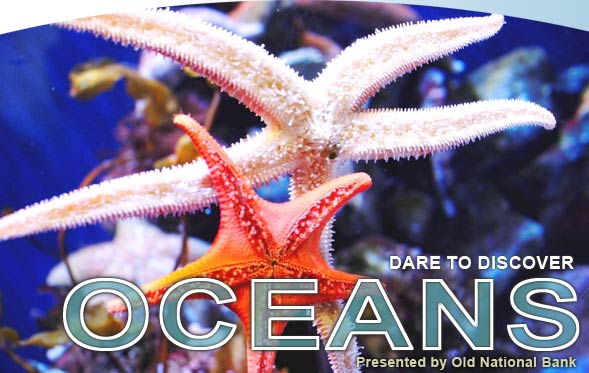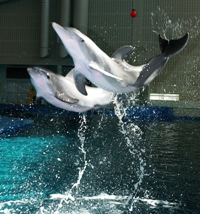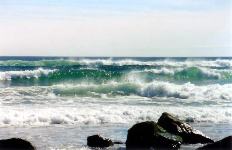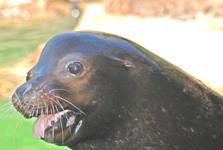 |

Welcome to the Oceans Marine Mammals Exhibit at the Indianapolis
Zoo in Indianapolis, Indiana! I hope you enjoy the Photos and Information on the Mammals. Please come back often and bring
all your Family and Friends with you so they too can enjoy all the Photos!
GOD BLESS ALL OF YOU AND YOUR FAMILIES!!!!
A Marine Mammal is a Mammal that is primarily Ocean-dwelling
or depends on the Ocean for its Food. Mammals originally evolved on Land, but Marine Mammals evolved to live Back in the Ocean.
There are Five Groups of Marine Mammals:
1. Order Sirenia: the Manatee, Dugong
2. Order Carnivora; Family Ursidae: the Polar Bear
3. Order Carnivora, Infrafamily PinniPedia: the Seal, Sea Lion, and Walrus.
4. Order Carnivora, Family Mustelidae: the Sea Otter and Marine Otter
5. Order Cetacea: the Whale, Dolphin, and Porpoise
The Indianapolis Zoo is very lucky to have an excellent Group of Marine Mammals in its Collection.
Although these Animals are Cared for within their own Department at the Zoo. Several of them are Physically connected to the
New Oceans Exhibit. While the Dolphins and Walrus have their own Habitats, the Harbor Seals, Gray Seals, California Sea Lions
and the Polar Bears all have Underwater viewing areas inside the Oceans Building.
| LEAPING DOLPHINS |

|
| AT THE EXHIBIT SHOW AT THE INDIANAPOLIS ZOO!!! |
Marine Mammals vs. Fish
Since Mammals originally evolved on Land, their Spines are optimized for Running, allowing
for up-and-down but little sideways motion.
Therefore, Marine Mammals typically swim by moving their Spine up and down. By contrast, Fish
normally swim by moving their Spine sideways. For this reason, Fish mostly have Vertical Caudal (Tail) Fins, while Marine
Mammals have Horizontal Caudal Fins.
Some of the primary differences between Marine Mammals and other Marine Life are:
. Marine Mammals breathe Air, while most other Marine Mammals extract Oxygen from Water.
. Marine Mammals have Hair, but Crustaceans have very little, usually a very few bristles
retained around the Head or Mouth. All Members of the Carnivora have a Coat of Fur or Hair, but it is far thicker and more
important for the Thermoregulation in Sea Otters and Polar Bears than in Seals or Sea Lions. Thick layers of Fur contribute
drag while swimming, and slow down a Swimming Mammal, giving it a disadvantage in Speed.
. Marine Mammals have thick layers of Blubber used to insulate their Bodies and prevent Heat
Loss. Sea Otters and Polar Bears are exceptions, relying more on Fur and Behavior to stave off Hypothermia.
. Marine Mammals give Live Birth. Most Marine Mammals only give Birth to One Calf or Pup at
a time, and are never able to Birth Twins or Larger Litters.
. Marine Mammals Feed off Milk as Young. Maternal Care is extremely important to the Survival
of Offspring that need to develop a thick insulating layer of Blubber. The Milk from the Mammary Glands of Marine Mammals
often exceeds 40-50% Fat Content to support the development of Blubber in the Young.
. Marine Mammals maintain a High Internal Body Temperature.
Unlike most other Marine Life, Marine Mammals carefully maintain a Core Temperature much higher
than their Environment.
Blubber, thick Coats of Fur, Bubbles of Air between Skin and Water, Countercurrent Exchange,
and Behaviors such as Howling Out, are all Adaptations that aid Marine Mammals in Retention of Body Heat.
The Polar Bear spends a large portion of its time in a Marine Environment, albeit a Frozen
One.
When it does swim in the Open Sea it is extremely proficient and has been shown to cover 74km
a day. For these reasons, some Scientists regard it as a Marine Mammal.
Marine Mammals and the Oceans
Because Humans and Marine Mammals share so much in terms of their relationships with the Oceans,
it is important to learn more about how we are related, how our actions affect each other, and what those actions can mean
for the Health of the Oceans on whose existence both of us ultimately depend.
Marine Mammals and People need Healthy Oceans to Survive.
| OCEAN WAVES WITH ROCKS |

|
When the Oceans are Healthy, Humans and Sea Creatures can
thrive side by side. When Pollutants wash into the Oceans, Sea Creatures and People around the World Suffer.
We share the Coasts.
Nearly half the World's Population lives near the Ocean, sharing the Beaches and Waters with
Seals, Sea Lions and other Ocean Creatures. Things that impact the Health of the Oceans impact all Living Creatures.
We share a Taste for the same Food-Fish!
The average American eats about 27 Pounds of Saltwater Fish a Year. Nearly all of a Sea Lion
or Seal's Diet is Fish-and a lot of it. The Zoo's Largest Sea Lion eats nearly 25 Pounds of Fish a day.
Soon there may not be as many Fish around to eat.
Commercial Fishing Fleets are catching some Fish faster than they can reproduce and replace
themselves. Some of the Fish we love to eat-like Shark, Chilean Sea Bass, and Monkfish-may not be on the Menu in a few years.
Fewer Fish in the Ocean will affect Seals, Sea Lions and Humans.
We share threats to the Ocean's Health.
Pollutants washed into the Oceans can make Fish dangerous to eat and the Oceans unhealthy
to swim in. Many of the Fish we think are Tasty-like Shark, Swordfish, Wild Caught Striped Bass and King Mackerel-contain
so many Toxins they may be risky to eat.
| FUNNY, THE SEA LION! |

|
| AT THE INDIANAPOLIS ZOO!!! |
CALIFORNIA SEA LION
Description of Species:
California Sea Lions have Long Torpedo Shaped Bodies covered in Short Coarse Hair. They are
distinguishable from Seals because they have External Ear Flaps. Sea Lions have Flippers that are used both for swimming and
mobility on Land. The Flippers are Long and Leathery with Nails. Males are darker and larger than the Females.
Males weigh between around 850lbs. to possibly over 1,000lbs. They can grow up to Six Feet
in Length. Their Necks are quite thick and they "have a Mane of longer Hair on the Neck." Females grow to around 220lbs. and
up to Six Feet in length.
Coloring of the Species ranges from a Light Golden Brown to a Dark Chocolate Color. The Males
tend to be Dark Brown, while the Females are nearer to Golden Brown.
The Genus Name "Zalophus" comes from "two Greek Words: Za, an Intensifying Element and Lophos,
meaning Crest." Around the Fifth Year, a Male will develop a High Bony Crest on its Head that can be as high as 1 1/2 inches
in height by the time the Male is Ten Years Old. Vocalizations are frequent and play an important part in maintaining Territorial
Boundaries. The Barking is also used as a Signal for Danger.
Habitat and Diet:
California Sea Lions live on Rocky Coastline, Surf and Open Sea.
They are partial to Island Habitats and Rocky Coastline because these areas are isolated from
the Mainland and many Predators. It also is the home of their favorite types of Food.
California Sea Lions prefer Squid and Octopus but they will eat Fish like Hake and Herring.
They have also been known to eat Shellfish and even Seabirds. The Mating Season, which occurs from May to July, affects the
appetites of the Adult Animals, the Males in particular.
Natural History:
The California Sea Lion's Breeding range extends from the Channel Idlands off Southern California
along the Coast of Mexico to Tres Marias Islands. Pups are Born on the San Miguel and San Nicholas Islands in the Channel
Island Chain. Other Birthing areas are a few Islands off the Pacific Coast of Baja California.
Occasionally Pups are also Born on Ano Nuero and the Farallon Islands.
San Miguel Island, one of the Eight Channel Islands, is the only place in the World where
Five Pinniped Species-California Sea Lions, Stellar Sea Lions, Harbor Seals, Northern Fur Seals, and Northern Elephant Seals-Congregate
and Breed.
Males will Mate with an average of 16 Females in one Season. The Bulls patrol Territory ferociously
and defend their Harems of up to Forty Cows. Territorial Male Displays include Oblique Stares, Head Shaking, Barking and lunges
toward the Opponent. Such interaction between Territoial Males rarely results in Physical Damage to either Animal. Sea Lions
have the ability to delay implantation by up to Three Months and the average Gestation Period is Nine Months.
Sea Lions Mate Twenty to Thirty days after giving Birth to their Pup. There is only about
One Month out of the Year that a Female isn't Pregnant.
A Newborn Pup measures about 30 inches and weighs 131lbs. The Pup swims on its own at Two
Weeks and Weaning is complete after Five or Six Months. Lactation begins about Two Hours after the Birth.
The Cow's Milk is 36 Percent Fat and 14 Percent Protein and Lactose-Free.
Nursing occurs at about Two-Hour intervals and lasts about Ten Minutes.
Females return to the Sea to Feed in between Nursings, leaving their Pups on the Shore. When
they return, they identify their Pups through "Vocalizations and/or Scent."
The California Sea Lion is flourishing. Population figures for the California Sea Lion are
estimated at between 50,000 and 150,000 Individuals and that they are growing at an annual rate of up to Five Percent.
In the early 1800s, the California Sea Lion was hunted extensively, mostly for the Oil from
their Blubber, which had various uses.
Commercial Fishermen and Fishing Nets have also been a Factor in California Sea Lion Mortality
Rate. Since Commercial Fishermen continue to overfish the Oceans, the competition between the Sea Lions and the Fishermen
is intensifying. Resources are becoming scarcer, which puts pressure on the Total Population.
Other Interesting Issues:
Sea Lions are not fully committed to the Sea. They must come Ashore to Rest and Breed. They
stick close to the Shoreline when their Food Sources are abundant and they can relax on a Rocky Beach if they are so inclined.
The Marine Mammal Protection Act of 1972 recognized that certain Species and Populations may
be in danger as a result of Man's Activities and these Species must not be allowed to drop below viable numbers. This Act
also prohibits Harassment of any kind of these Species. This has helped the California Sea Lion Population rebound in the
United States.
The Spring 2001 Issue of the Newsletter of the Marine Mammal Center reported that the Center
has found a high rate of Cancer among California Sea Lions. 18% of those examined Post-Mortem were found to have Cancer most
commonly in the Urinary and Genital Tracts.
This incredibly high rate of Cancer could be due to high concentrations of PCBs and Organchlorinated
Pesticides that run off of Land and work their way up the Food Chain to the Sea Lion. While the California Sea Lion Population
is not endangered, this Species could serve as an Indicator Species on the Overall General Health of the Coastal Food Chains.
|

